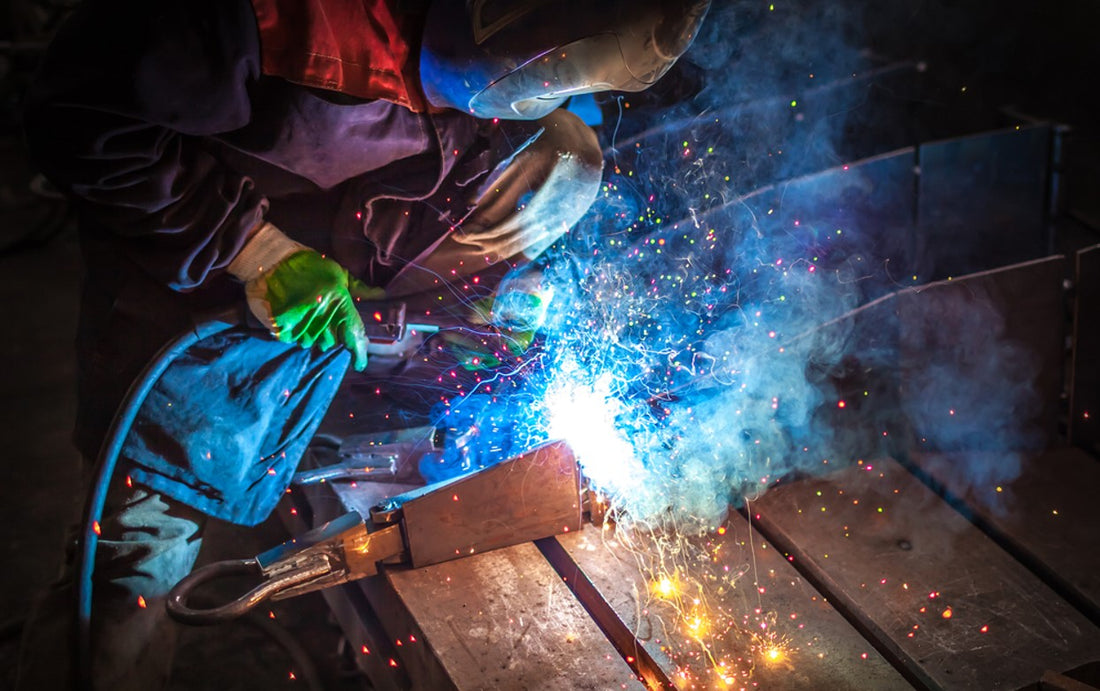When it comes to MIG welding, shielding gas is a critical component of doing it properly. In this article, we’ll hash out the details about shielding gas and its various types, its purpose, use and applications, and relevant safety procedures for handling it so that you are fully equipped to choose the right shielding gas for your MIG welding job.
Let’s first define shielding gas. MIG welding, or metal inert gas welding, is a kind of arc welding that uses an inert gas that acts as a protective shield for the high-temperature welding wire electrode and workspace from environmental contamination.
The primary contaminants are natural elements – oxygen and nitrogen – produced at high temperatures. These can do a heavy amount of damage in various forms to your workpiece. We’ll explain more below.
From this, you can see the clear importance of shielding gas in the MIG welding process. Also important to know is that there is another type of protective shield you can use in your welding job, which is what’s called flux shielding.
While this type of shielding doesn’t use a layer of gas, it uses solid flux or a flux core within the electrode welding wire to protect that electrode and the workplace from the same contaminants as shielding gasses.

Types of Shielding Gas
Let’s now go through all of the various types of shielding gas. They are:
- Argon (Ag): Ag is arguably the most frequently used type of shielding gas.
- Helium (He): This is slightly less popular but still frequently used. As a gas, helium is lighter than argon gas, which means that when using it, you must increase the gas flow rate for a proper protective shield.
- Argon and helium gas mixture: Combining these two gasses and their advantages of high density and high thermal conductivity produces a versatile shielding gas.
- CO2: Carbon dioxide is another type of shielding gas. Cheaper and active at higher temperatures, pure CO2 presents such benefits as the production of separate oxides (elements broken down into their singular atomic structures) that fall across the weld pool, making less molten metal alloy and more Mg (manganese) and silicon.
- Ag + CO2: CO2 is used much more infrequently these days. What’s more common is a gas mixture of argon and CO2.
- Ag + O2: The argon and O2 mixture also presents good substrates for shielding gas. Oxygen here is used at a very minimal level, but that minimal level, when broken down into an oxide, helps stabilize the arc in particular MIG welding processes.
- Ag + H2: The combination of argon and hydrogen increases the thermal conductivity of Ag and contributes to welding speed efficiency and other factors.
What Types of Shielding Gas Should I Use for Different Jobs?
This is the next logical question to ask. Don’t worry; we’ve got you covered, having created a list that explains the best matches.
- Ag is the most versatile shielding gas. It can be used for welding any metal, both ferrous metal (with iron) and non-ferrous metal (without iron).
- He is best used for metals like aluminum, copper, and magnesium, particularly at higher thicknesses.
- The Ag + He mixture is best used with the thickest metals, like copper or aluminum alloys.
- Ag + CO2 mix (75 Ag:25 CO2) ratio is best suited for welding carbon steel. At a ratio of 98 Ag: 2 CO2, you’ll get the most benefit for carbon steel, stainless steel, or HSS (high-speed steel) welds.
- Using Ag + O2 will provide the most benefit for stainless steel and carbon steel jobs.
- Using H2 and Ag together provides the best shielding gas for stainless steel, nickel, and nickel alloys.
Other Factors to Consider When Choosing a Shielding Gas
Here are the other important considerations to keep in mind when choosing a shielding gas:
- Determine the thickness of the metal you’re going to weld.
- Determine the time limit for your job. This is key because welding outside can expose the metal to contaminants more rapidly and at higher volumes. The wind can also cause burns. Also important to note here is that mixing gasses is convenient for shorter jobs, as changing the shielding gas takes time.
- Be aware of your personal preference. Upon having accurate information as to which gas is best for which metal and at what thickness, know that you have options.
- Know the position you’ll be welding in. For horizontal or flat positions, heavier gasses are called for. For the vertical position, use a gas that’s lighter than air.
- Determine the age of your welding machine. For new machines, you have more options, while for older ones, argon gas is best because older machines are not compatible with newer gas uses.

Frequently Asked Questions
1. What is the difference between pure Argon and Ag+CO2 mixtures?
Ag is a universally-compatible shielding gas. Ag+CO2 combines these two gaseous formations at specific ratios for different jobs. For instance, higher concentrations of Ag in the mixture are better for axial spray transfer and are compatible with carbon steel, stainless steel, and HSS. Lower concentrations of Ag and higher concentrations of CO2, on the other hand, are best for carbon steel.
2. Can I use the same shielding gas for different materials?
In brief, yes, but each gas or gaseous mix has only specific materials it’s suitable for. So while you can, in effect, use gas for multiple materials, there are also metals excluded from its use.
3. What is the shelf life of shielding gas?
Approximately three years.
In Conclusion
We hope you’re having fun learning about the different gasses, metals, and procedures in our articles. This article should be particularly useful if you’re new to metal inert gas welding and must be appropriately trained and educated. Visit Ecenrode Welds today for products and services for your MIG welding needs!

